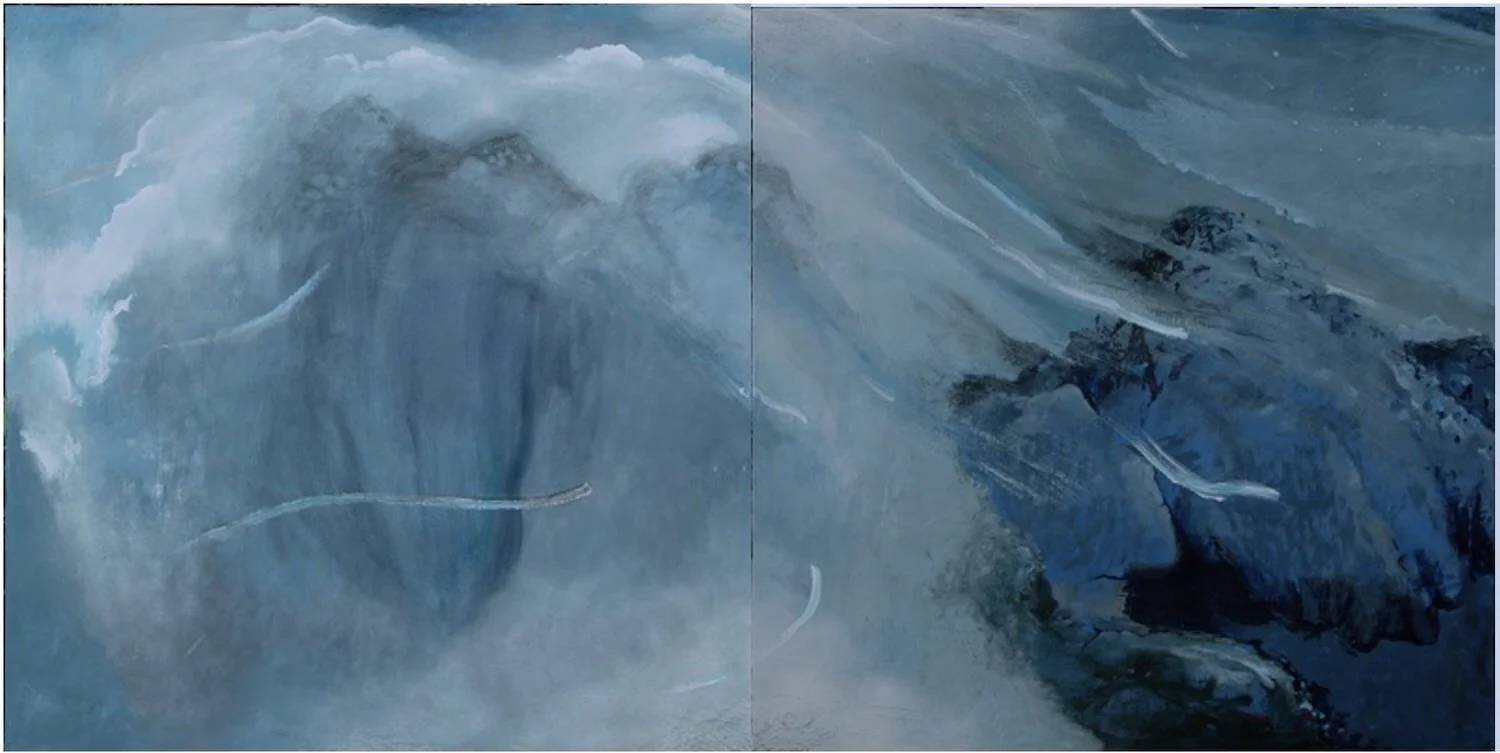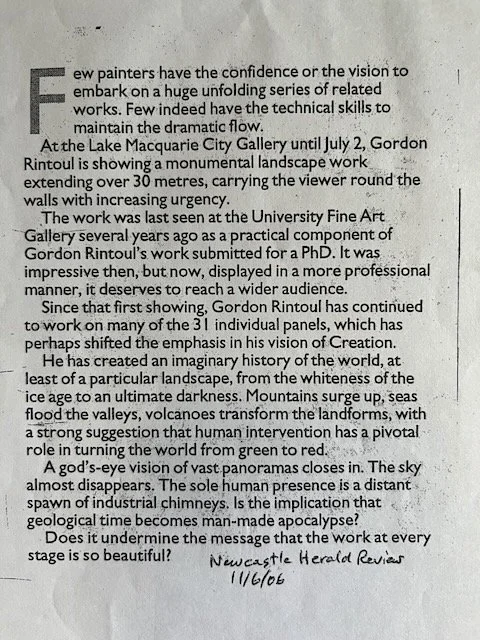Lamentations for lost landscapes -
Fine Art PhD thesis exhibition 2003 - a 41 panel large-scale panoramic work
Nature still has an awesome raw power but we can now see its fragility. Through this series, I hope that people are made even more aware that while we depend on nature, nature now depends on us.”
The early industrialisation of a remote part of South Western Tasmania seems an unlikely source for a group of large-scale landscape paintings, but the area around Queenstown represents some of the more ominous relationships technology has had with the natural world. It was here in the 1890’s that some of the world’s most inventive mining engineering provided a catalyst to transform one of the cleanest environments in the world into the most polluted in the Southern Hemisphere. The paintings speculate upon the damage man can create upon nature, and, ultimately to himself, and, in so doing, is cast in a mood of lament.
Lamentations of lost landscapes is the practice-led PhD thesis exhibition that provides a culmination of approaches from many strands established and researched over fifty years of painterly activity and is united into one epic painting exceeding 48 metres in length, a panoramic painting with 41 panels, each 120cm x 120cm.
“The importance of the narrative inspired the dimensions of this exhibition. There are two types of time shown. The early segments of the ice age leading to forestation are of geological time, which moves very slowly. Nature’s changes are slow and imperceptible over eons.
The tempo increases in the minis section, which is of human time and the subject matter includes contemporary political concerns such as land clearance, forest destruction, water policies, global warming and so on, followed by poisoned air, water and aridity, these changes in nature have now become rapid, dynamic and unstable and both complex and unpredictable.
The work has been shown in various forms at The University Gallery, Newcastle (2003), the Museum of Art and Culture yapang, Lake Macquarie (2006, 2012), Tweed River Art Gallery, Tweed Heads (2007), Burnie Regional Art Gallery (2008).
See full continuous panorama of the Lamenations of Lost Landscapes series on Youtube here and the PhD Synopsis below.
2012 Lost landscapes exhibition Museum of Art and Culture yapang, Lake Macquarie
Below: 2012 exhibition where two sections of Lamentations for Lost landscapes
Newcastle Herald Review June 2006
From Tweed River Art Gallery exhibition program 2007
Gordon Rintoul’s large-scale painted panorama Lamentations for lost landscapes explores the turbulent history of the landscape surrounding Queenstown, an old mining town in southwestern Tasmania. During a visit to the area in 1965 Rintoul was struck by the visual drama of the desolate rocky moonscape superimposed within lush and serene rainforests.
In his 41-panel series Rintoul depicts an imagined painted history of the area, including the extremes of a bleak Ice Age, the growth of fertile lush vegetation, current ecological and mining issues, and a catastrophic and devastated future world.
This ambitious work revives the large-scale panoramic vista of landscape painting and makes time itself visible. The entire presentation is cast within a twilight end-of-day drama, symbolic of impending doom, which at the same time, reveals the awesome power and fragility of the natural world. Rintoul says, “while we all depend on nature, nature now depends on us”.
The importance of the narrative inspired the dimensions of this exhibition.
There are two types of time shown. The early segments of the ice age leading to forestation are of geological time, which moves very slowly. Nature’s changes are slow and imperceptible over eons.
The tempo increases in the minis section, which is of human time and the subject matter includes contemporary political concerns such as land clearance, forest destruction, water policies, global warming and so on, followed by poisoned air, water and aridity.
these changes in nature have now become rapid, dynamic and unstable and both complex and unpredictable.
Nature still has an awesome raw power but we can now see its fragility. Through this series, I hope that people are made even more aware that while we depend on nature, nature now depends on us.
2006 Lost landscapes exhibition Museum of Art and Culture yapang, Lake Macquarie
Below: 2006 exhibition of the 41-panel work
Lost Landscapes panel 8 & 9 2003 acrylic and oil on canvas on board 120cm x 120cm
Lost Landscapes panel 6 & 7 2003 acrylic and oil on canvas on board 120cm x 120cm
Lost Landscapes panel 6 & 7 2003 acrylic and oil on canvas on board 120cm x 120cm
Lost Landscapes panel 22 & 23 2003 acrylic and oil on canvas on board 120cm x 120cm
Lost Landscapes panel 25 & 26 2003 acrylic and oil on canvas on board 120cm x 120cm
Lost Landscapes panel 36 & 37 2003 acrylic and oil on canvas on board 120cm x 120cm
PhD Thesis Topic: Large-scale landscape painting responding to the relationship of industry and technology to environmental degradation.
THESIS SYNOPSIS
It is not necessary to show in this document the many achievements of technology: they are given. However, behind these exits, there is a different relationship with the natural world. The early industrialization of a remote part of Tasmania seems an unlikely venue to consider these wider issues, but at Mt. Lyell, Queenstown, where some of the world’s most inventive mining engineering was developed, at the same time, the worst environmental damage in the Southern Hemisphere occurred.
Queenstown will be remembered for the successful and hugely difficult extraction of massive amounts of copper, tin, gold and silver, which continues to this day, but also has a powerfully symbolic, no less potent legacy of a tragic history of human indifference to finite natural resources.
The exhibition shows the damage mankind can create without vigilance upon nature, and ultimately on ourselves. The exegesis provides evidence to support this view.
In the exegesis, narrative approaches are outlined and references to the Sublime in landscape painting, the spiritual in nature, the panorama as compositional form and the revival of Romanticism in landscape art is made. To place the artwork in its context a brief study of relevant artists is included together with related ecological, historical and geographic issues. Formal decision-making, creative and working processes are described to document the exhibition’s history of manufacture. Three of Australia's most prominent artists, Jan Senbergs, William Robinson and Mandy Martin, whose work parallels differing aspects of the exhibition, have been interviewed and comparisons made.
The approach adopted for the exhibition is to combine over forty-one consecutive and related representations to form one complete whole. The presentation also responds to the exhibition space in its installation, enabling new references and interpretations. This exhibition space provides a venue for the presentation of the natural sublime and the industrial sublime, although this may be referred to, when together, as the ecological sublime.
Below: a selection of Lamentations for Lost landscapes panels











